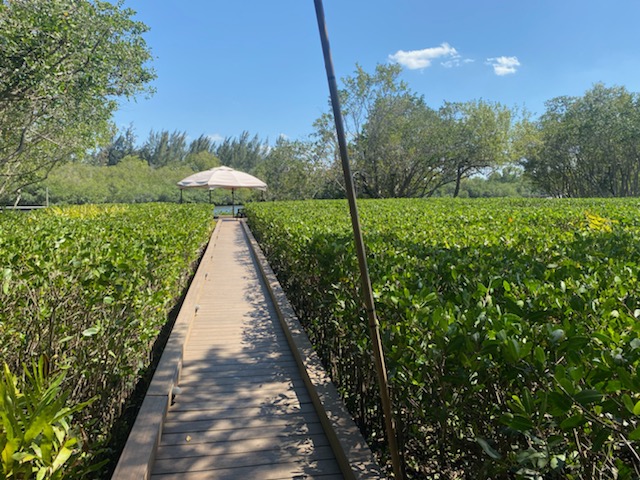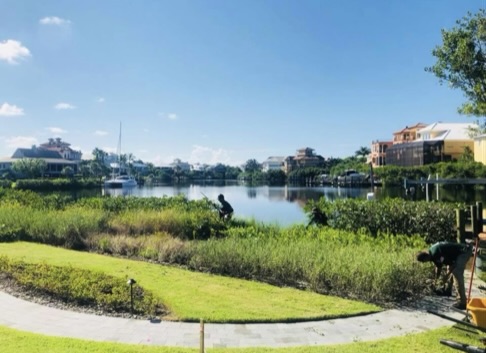
Mangrove trees are fascinating and vital components of Florida’s coastal ecosystems. These unique trees facilitate shoreline stabilization and water filtration and enhance the overall health of the ecosystem they grow in. They have the ability to trap and absorb carbon dioxide emissions and other greenhouse gases from the atmosphere. Mangroves also provide productive habitats for several species of flora and fauna. Additionally, mangrove forests are great locations where people can relax and meditate. Here are some more interesting facts about mangroves.
Fact #1: Florida Is Home to Three Types of Mangroves
While there are around 50-80 mangrove species in the world, Florida is home to three: the red mangrove (Rhizophora mangle), the black mangrove (Avicennia germinans), and the white mangrove (Laguncularia racemosa).
The red mangrove is the most well-known and typically grows along the water’s edge. It can be easily identified by its tangled and reddish roots. These “prop-roots” give red mangroves their nickname “walking trees.”
The black mangrove usually occupies higher elevations and is recognizable by finger-like projections that protrude from the soil around the tree’s trunk. These projections are pneumatophores.
The white mangrove, found farther upland, lacks visible aerial roots but can be identified by its elliptical, light yellow-green leaves with distinctive glands at the base.
Florida is home to tropical mangroves, and they exhibit sensitivity to extreme temperature changes and subfreezing temperatures. Various factors, such as salinity levels, water temperature, tidal fluctuations, and soil conditions, influence the growth and distribution of mangroves. While they are commonly found as far north as Cedar Key on the Gulf Coast and St. Augustine on the Atlantic Coast, black mangroves have a wider range and can occur farther north in Florida compared to the other two species. It is quite common to see all three species growing together, with their distinct characteristics intermixed within the mangrove habitats.

Fact #2: Mangroves Help Maintain Shoreline Stability
The dense network of roots stabilizes coastal soils, protecting the shoreline from erosion, which is the process by which soil, rock, and sediment wear away due to wind, rain, and other elements. Mangroves’ extensive root systems also act as natural buffers against storms and tidal fluctuations. By absorbing overflowing water, mangrove forests help protect people who live along the South Florida coast from floods.
Since the risk of storms in Florida has increased over the past 30 years, the benefits of mangrove forests shouldn’t be underestimated. According to reports, the presence of mangroves resulted in a reduction of the annual flood risk by 25.5% in Collier County. Numerous areas in the county experienced substantial benefits, with over $1 million saved annually in flood damage reduction.
The value of mangrove forests was particularly evident during extreme weather events such as Hurricane Irma. These remarkable trees prevented approximately $1.5 billion in storm damage. Moreover, they played a crucial role in safeguarding the well-being of more than 626,000 individuals across the state of Florida.
Fact #3: Mangroves Facilitate Water Filtration
Unlike most trees, mangroves thrive in saline or brackish water. They have unique features that help them deal with high levels of salinity. Some species secrete excess salt after absorbing it, while others filter out salt from the surrounding seawater. Mangroves help with water filtration, thus improving water quality and clarity. They filter pollutants, absorb excess nutrients from runoff, and trap sediments.
Fact #4: Mangroves Offer Habitats for Wildlife
The intricate root systems of mangroves offer nesting locations and roosting sites for various bird species, including coastal wading birds such as egrets, herons, cormorants, and roseate spoonbills. Many marine species, including fish, crustaceans, shellfish, and oysters, rely on mangroves for food and shelter.
Mangroves serve as protected nursery areas for numerous commercially and recreationally important fish species, ensuring the sustainability of Florida’s fisheries. Additionally, endangered species like the smalltooth sawfish, manatee, hawksbill sea turtle, Key Deer, and Florida panther depend on mangrove habitats during some stages of their life cycles.
Fact #5: Mangroves Have Unique Seed Germination Strategies
All three mangrove species in Florida use a fascinating method of reproduction. Rather than relying solely on dispersal through wind or animals, these trees have a unique method for propagation. The seeds of mangroves actually begin to sprout while still attached to the parent trees.
Once the germination process is underway, the seeds either fall directly into the soft sediment surrounding the base of the trees or are carried by currents and tides to find suitable locations elsewhere. This remarkable adaptation ensures the dispersal and establishment of new mangrove colonies, contributing to the resilience and expansion of these important coastal ecosystems.
Threats That Mangroves Face
Unfortunately, mangroves face a multitude of threats that endanger their existence and the critical benefits they offer to coastal ecosystems. Human activities pose significant challenges to these valuable habitats. Dredging, filling, and the pollution of water with herbicides are some of the destructive practices that can lead to mangrove erosion and irreversible habitat destruction. When mangrove forests are cleared and destroyed, this leads to the release of massive amounts of carbon dioxide into the atmosphere, which contributes to the already pressing issue of climate change.
To protect and conserve mangrove forests, Florida has established the Mangrove Trimming and Preservation Act, which regulates the trimming and alteration of mangroves to prevent harmful effects on the ecosystem. It is important to call in professionals with mangrove permits and experience in mangrove trimming before considering any pruning or removal activities. The ISA-certified experts at Joshua Tree are equipped to perform mangrove trimming, mangrove pruning, and mangrove removal within Florida regulations to help improve your waterfront view or increase access to local waterways. Contact us today!
